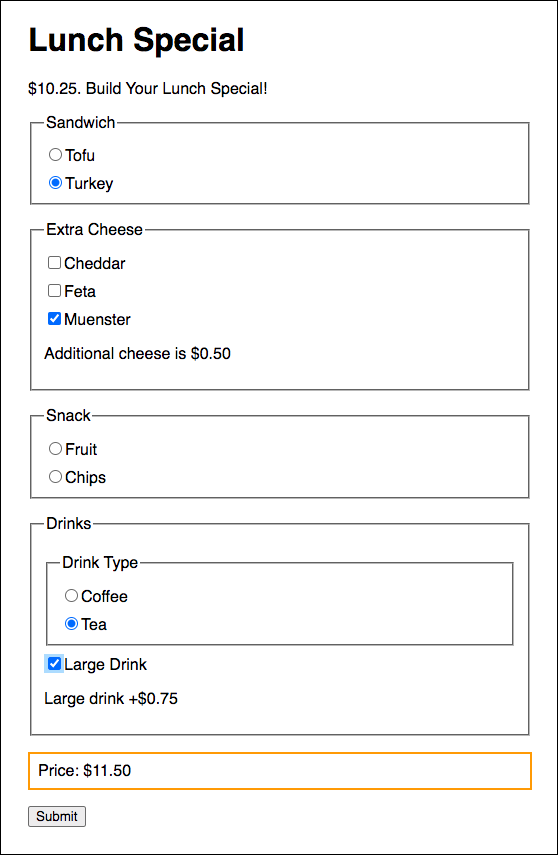Session 11 - JavaScript, Part 4
Harvard Extension School
Spring 2021
Course Web Site: https://cscie12.dce.harvard.edu/
Topics
- XHR or Ajax
- JS Data Structures - array and "object" (key/value pair)
- JSON - Creating Content with JS and DOM
- JSON - Creating Content with jQuery
- Creating Content with XHR, jQuery, and JSON
- Same Origin Policy and CORS
- Javascript Templates
- JavaScript Templates - Example
- JavaScript Templates - Apple Picking
- JavaScript Templates - Courses
- Course Search Example - Live!
- Handlebars - A few more notes
- Handlebars - Compiled Templates
- Maps
- Google Maps JavaScript API
- Map with Several Markers
- Maps - Leaflet JS and Open Street Map
- Pancake Menu
- Form Price Calculation
Presentation contains 30 slides
XHR or Ajax
XHR/Ajax flow: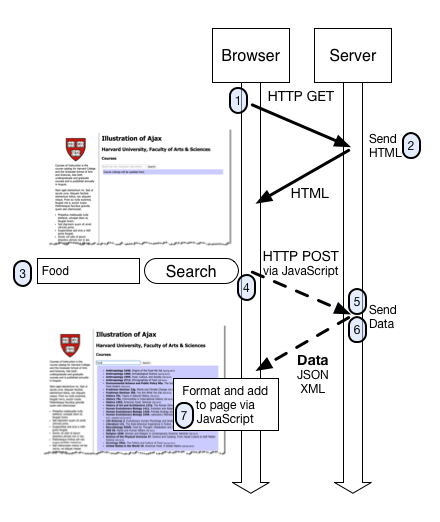
- The browser makes an HTTP GET request for the search page
- The server responds with the HTML content.
Note that we are not showing browser requests for other page resources such as image, CSS, or JavaScript files - The user types in a search term and clicks the submit button (or presses "enter")
- A JavaScript event handler is triggered on the form submit, and JavaScript sends an HTTP request via the browser to the server. This HTTP request contains the search term typed in by the user as a parameter sent to the server
- A program on the server searches the course database for any courses that contain the search term.
- The program (via the web server) returns the matching courses in a data format to the browser (typically in JSON format)
- The browser receives the data, hands it off to the JavaScript, and the JavaScript formats the data into HTML and updates the search area on the page
What the browser does
- Initiates an HTTP request to server, and receives data
An event handler in JavaScript for the form submit is triggered, and JavaScript sends an HTTP request to the server that includes the search term the user typed in. In an Ajax context, the response from the server is not necessarily HTML meant to be displayed directly, but is data. - Formats and Displays Data on the Page
The JavaScript that is part of the page is used to format the data into markup, and then place this newly created markup on the page itself so that it is displayed to the user.
What the server does
The server is simply responding to HTTP requests, and sending responses back to the browser. The "how" of looking up courses in a database based on a keyword search term is beyond the scope of this lesson -- we will demystify that part later in the course.
A Collection of Technologies
So we see Ajax is really a collection of technologies that are working together to send and receive data to and from the web server based on user actions, and to format and display this data to the user.
Some of the key technologies involved are:
- HTML
- CSS
- JavaScript
- DOM (Document Object Model)
The DOM is used to format the content and manipulate the content of the page that is displayed in the browser. - XHR object (XHR = XMLHttpRequestObject)
This is the object in JavaScript that constructs and sends the request back to the server
- DOM (Document Object Model)
- Data formats
- JSON (JavaScript Object Notation)
What can you do with Ajax/XHR?
- Partial update of page
- Periodic polling for new/changed data
- "Event"-driven interaction (instead of 'form submit'-driven)
- click, mouseover, submit, etc.
- Incorporate data and functionality from other sites into your web site
- Your data + functionality from elsewhere
- Your functionality + data from elsewhere
JS Data Structures - array and "object" (key/value pair)
JSON - JavaScript Object Notation
JSON array Example:
['Autumn', 'Winter', 'Spring', 'Summer']
JSON object Examples:
Simple "name/value" pairs:
{
"lastName" : "Bacow",
"firstName" : "Lawrence",
"email" : "president@harvard.edu"
}
"name/value" pairs, with values being an array (list) of things:
{
"apples" : ['Macoun','Empire','Honey Crisp','Albemarle Pippin'],
"oranges" : ['Naval Orange','Tangelo','Clementine','Valencia Orange']
}
More about JSON
A data format widely used in Ajax is JSON -- this format is used to pass data from the web server to the browser, and it is in a format that is easily worked with in JavaScript.
We first need to take a look at the JSON format and how we can work with it, and then we'll see how this works together in Ajax.
The introduction to JSON from json.org is a great place to start:
JSON (JavaScript Object Notation) is a lightweight data-interchange format. It is easy for humans to read and write. It is easy for machines to parse and generate. It is based on a subset of the JavaScript Programming Language, Standard ECMA-262 3rd Edition - December 1999. JSON is a text format that is completely language independent but uses conventions that are familiar to programmers of the C-family of languages, including C, C++, C#, Java, JavaScript, Perl, Python, and many others. These properties make JSON an ideal data-interchange language.
JSON is built on two structures:
- A collection of name/value pairs. In various languages, this is realized as an object, record, struct, dictionary, hash table, keyed list, or associative array.
- An ordered list of values. In most languages, this is realized as an array, vector, list, or sequence.
These are universal data structures. Virtually all modern programming languages support them in one form or another. It makes sense that a data format that is interchangeable with programming languages also be based on these structures.
More JSON objects
In short, a JSON object is an unordered list of name/value pairs.
A JSON object example:
Note that the object (collection of name/value pairs) is enclosed in {curly braces}.
The name/value pair has a colon after the name (i.e. name: value), and the name/value pairs are separated by a comma.
So the object above represents the following:
| Name | Value |
|---|---|
| lastName | Bacow |
| firstName | Lawrence |
| president@harvard.edu |
JSON Array
In short, a JSON array is an ordered sequence of values. Values are strings (in quotes), numbers, arrays, objects, or boolean (true/false) values.
A JSON array example
Strings, Objects, and Arrays can all be values!
In the examples above, we've shown the values as strings (e.g. "Spring" or "Bacow"). But values can also be arrays or objects. Below is a more complex JSON object that includes two name/value pairs whose values are an array of strings ("seasons") and the other an array of objects ("days"):
There are several online JSON viewers and validators you can use that are helpful for exploring, writing, or validating JSON structures:
JSON - Creating Content with JS and DOM
JSON - Creating Content with jQuery
Now that we have a sense of JSON and its "object" and "array" structures, let's see how we can create content from JSON using JavaScript.
We'll use the jQuery JavaScript library to build up markup based on data in the JSON structure, and then we'll place it on the page.
We'll use the "seasons" array to build an unordered list of seasons.
The JSON data:
The result we will build: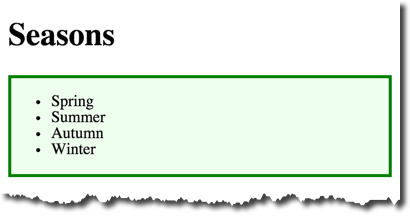
Let's take a look at the important parts:
HTML:
JavaScript:
var mydata = {"seasons":["Spring", "Summer", "Autumn", "Winter"]};
The JSON data structure. An object with a single name/value pair (name is "seasons" and value is the array of 4 strings)var ul_node = $('<ul>');
Use jQuery syntax to create aulnode,
for (var s of mydata.seasons) {
Iterate through the array.var li_node = $('<li>');
Use jQuery syntax to create anlinode.li_node.text(s);
Set the text value of thelinode to be the value of the array item (e.g. first time through the loop, this creates
ul_node.append(li_node);
Append thelinode to theulnode (e.g. the first time through the loop, we will then have
}
this is the curly brace to close the close the loop started infor (var i in seasons) {$('#seasons_container').append(ul_node);
Finally, once theulis completed, we append it to the element whose id is#seasons
All Together
Complete markup is:
Creating Content with XHR, jQuery, and JSON
So now we'll bring Ajax into the picture by requesting data from the server. The server will return the seasons JSON data, and we will then pass array of seasons to our function that will create the unordered list.
The jQuery library makes working with Ajax requests very easy. jQuery has a getJSON method that makes requesting and receiving JSON data from the server easy. In the simplest case, we'll pass two parameters when we use the getJSON method: a URL that will be requested, and a "callback" function that will be called on a successful retrieval of JSON data. A simple case where we make a JSON request to the url "seasons.json" and simply log the data to the JS console looks like:
$(document).ready(function(){
$.getJSON("seasons.json",function(data) {
console.log(data);
});
});"seasons.json"
This is a relative URL that will be requested.function(data){ console.log(data); }
This is the callback function that is called when the JSON request is successfully completed. Note thedatais the data from the JSON request.
All together
So we take our previous example, where we built a list from a JSON data structure, and change it so that the JSON data comes from an Ajax request (using the getJSON) method of jQuery:
Same Origin Policy and CORS
When working with XHR/Ajax, it is important to understand some basic concepts of web application security. Some concepts we'll briefly describe are:
- Same Origin Policy
- CORS (Cross Origin Resource Sharing)
These are important to understand since the browser restricts the XHR calls allowed.
Same Origin Policy
This is the simplest policy, and will cover all cases where the data you are requesting comes from the same hostname as the page making the request.
Under the same origin policy, a web browser will permit JavaScript contained in a web page to access data from the same origin -- or the same "hostname" of the URL.
So if your JavaScript and the data it is accessing all come from the same origin (hostname in the URL), the browser will permit this communication.
If the JavaScript and the data come from different origins (hostnames), then the browser will block this for security reasons.
For JavaScript to access data that comes from different origins, you'll need to make sure CORS headers are set correctly.
CORS - Cross Origin Resource Sharing
CORS is a common and preferred method for handling cross-origin requests.
Using CORS, it is possible for the browser and server to determine whether or not to allow a cross-origin request. This happens as part of the HTTP request. The server can specify access control rules, which a browser will then use to determine whether a cross-origin request is permitted.
We won't go into how make the server-side CORS compatible right now. From the front-end perspective, it is enough to understand that you are using a CORS-enabled service. You don't need to do anything to enable CORS from within your JavaScript -- it already is there and is used by the browser.
HTTP response header:access-control-allow-origin: *
For example, the service from "cdn.rawgit.com" (e.g. apples.json) uses CORS, which is why the "Pick Your Own Apples" example worked fine, despite the different origins between the page the JSON.
MDN: Cross-Origin Resource Sharing
Javascript Templates
Having the separation of data coming from the server-side in the form of JSON (or even some other format), and doing the work to display and present it on the client-side is a beneficial separation of concerns. If the formatting and display requirements change, it is a change to the front-end (client-side) code (HTML, CSS, JS) as opposed to the server-side. However, while the technique we've seen to process JSON into markup and place it on the page is entirely on the client-side (as opposed to server-side), a big drawback is that we've done this entirely in JavaScript.
For example, to build a list of seasons, we did something like:
Good News: We do have separation between front-end and back-end! Front-end does the structuring and display; the back-end provides the data.
Bad News: We have mixing of concerns between structure (markup) and function (JavaScript). We do not have good separation between structure (HTML), style (CSS), and function (JS) within the front-end. We have to read through the JavaScript to figure out how our data will be structured. If we want to change how the data is structured, we need to edit the JavaScript.
Better with Templates!
Using JavaScript templates, building a list could look something like:
There are a variety of libraries for making templates in JavaScript. I'll mention four here, and we'll focus on one in our examples (Handlebars):
- Trimpath JavaScript Templates (JST)
- Mustache, "Logic-less" templates
- Handlebars, Handlebars provides the power necessary to let you build semantic templates effectively with no frustration.
KISS - Keep It Simple.
Before we get started with an example, I want to put a strong recommendation to follow the keep your templates simple principle. Trimpath JST and Mustache forces you to do this -- with Handlebars, you can keep your templates simple, but you can make them complex. Remember that the prime benefit we want to achieve with templates is for our presentation format to be defined separately from our JavaScript code. The more complex our templates get, the further we get from achieving that benefit.
JavaScript Templates - Example
We'll focus on using the Handlebars template library. Other template systems will do similar things though, with different syntax.
With Handlebars, the key parts are:
- Write a "Handlebars" template
- Load the "Handlebars" JavaScript library
- Compile the template using Handlebars
- Evaluate the template, passing in the data
- Add the result of the processed template to the page
Handlebars syntax are based on double curly braces, like {{ handlebar expression }}.
So to iterate through the <code>seasons</code> array, our Handlebars template would look like:
<ul>
{{#seasons}}
<li>{{.}}</li>
{{/seasons}}
</ul>To re-implement our "seasons list" example using Handlebars, we could something like:
- The Handlebars template is defined in Lines 32-38.
This template iterates through theseasonsarray{{#seasons}}starts the iteration{{/seasons}}ends the iteration- Within the loop,
{{.}}refers to item of the array
display: none;by CSS. There are other ways to include templates, which we'll discuss a bit later. - Line 11. Load jQuery for Ajax request and DOM manipulations. We're using the jQuery CDN here.
- Line 12. Load Handlebars JS library from the cdnjs.com service.
- Line 15. Here we define the URL we'll get our seasons list from.
- Line 18. Use jQuery to make the Ajax request, and set the callback function to process the data
- Line 20. Get the template source (uses jQuery to select the
#seasons_templateand get thehtml - Line 21. Use Handlebars to compile the template. This makes the template ready to process. Under the hood, the compile step turns our {{ handlebars template }} into JavaScript code.
- Line 22. Evaluate the template, passing in the data. The evaluation will return the markup generated.
- Line 23. Add the results of the template evaluation to the page. Note here we are using jQuery.
See the working examples:
JavaScript Templates - Apple Picking

JSON Data
{
"apples": {
"picking_now": [
"Macoun",
"Empire",
"Cortland",
"McIntosh",
"Honey Crisp",
"Gala",
"Red Delicious"
],
"picking_soon": [
"Golden Delicious",
"Northern Spy",
"Baldwin",
"Mutsu"
],
"picking_done": [
"Ginger Gold",
"Jonamac",
"Gravenstein"
]
}
}Handlebars Template
<div id="appleslisttemplate" class="handlebars">
<h3>Picking Now</h3>
<ul>
{{#apples.picking_now}}
<li>{{.}}</li>
{{/apples.picking_now}}
</ul>
<h3>Picking Soon</h3>
<ul>
{{#apples.picking_soon}}
<li>{{.}}</li>
{{/apples.picking_soon}}
</ul>
<h3>Missed Out for This Year</h3>
<ul>
{{#apples.picking_done}}
<li>{{.}}</li>
{{/apples.picking_done}}
</ul>
</div>JavaScript
let dataUrl = 'https://cdn.rawgit.com/dpheitmeyer/b9fe0838e27b28db1287/raw/38356d6675e355215b7bf22ff75c520a8fbe8850/apples.json'
$(document).ready(function(){
$.getJSON(dataUrl,
function (data) {
var mysource = $('#appleslisttemplate').html();
var mytemplate = Handlebars.compile(mysource);
var myresult = mytemplate(data)
$('#appleslist').html(myresult);
});
})JavaScript Templates - Courses
Let's take a look at a Handlebars template that processes information about Courses from the Faculty of Arts & Sciences at Harvard University.
Courses - ExampleCourses - JSFiddle
Course data. First, here is a JSON string built based on a query of the course database for all the courses with a keyword of "food". It would be typical to have this query built from a form and return "live" results in JSON, but to keep things simpler for this example, we'll just use this static list: courses.json
Handlebars template. In this JSON structure, there is an array of course objects (the "name" part is courses, the value is the array of course objects). In Mustache, we'll need to iterate through the courses, and for each one, we'll output some information about the course. Assuming we pass the Mustache template the JSON object above, this would look something like:
<div id="courselisttemplate" class="handlebars">
<ul>
{{#courses}}
<li class="course">
<span class="number">{{course_group}} {{num_int}}{{num_char}}</span>
<br/>
<span class="title">{{title}}</span>
</li>
{{/courses}}
</ul>
</div>Notice how we can simply reference the "name" of a name/value pair in an object, like {{title}}.
The above template would render like:
We'll make this example a bit more complete by adding the faculty_text and meeting_text to the output. Also, we can add the number of courses returned by using {{courses.length}}.
<div id="courselisttemplate" class="handlebars">
<p>{{courses.length}} courses were found</p>
<ul>
{{#courses}}
<li class="course">
<span class="number">{{course_group}} {{num_int}}{{num_char}}</span>
<br/>
<span class="title">{{title}}</span>
<br/>
<span class="faculty">{{faculty_text}}</span>
<br/>
<span class="meeting">{{meeting_text}}</span>
</li>
{{/courses}}
</ul>
</div>And the result would look like:
Course Search Example - Live!
Data
- Base URL:
http://cscie12.dce.harvard.edu/ajax/course_search - Expects "keyword" parameter which is the search term and "output=json"
- Example URL:http://cscie12.dce.harvard.edu/ajax/course_search?keyword=China&output=json
Markup (Form Part)
<form id="course_search_form">
<div>
<input type="text" id="search_query" name="search_query" size="40" placeholder="Search by title, instructor, description" />
<input type="submit" name="submit" value="Search" />
</div>
<div id="courselist">
Course Listings will be updated here.
</div>
</form>JavaScript
$(document).ready(function () {
console.log("DOM READY!");
var course_template_source = $('#courselisttemplate').html();
var course_template_compiled = Handlebars.compile(course_template_source);
console.log(course_template_source);
console.log(course_template_compiled);
$('#course_search_form').submit(function (e) {
console.log("form submitted!")
var search_term = $('#search_query').val();
console.log("search term is: " + search_term);
$.getJSON('/ajax/course_search', {
'keyword': search_term,
'output': 'json'
},
function (data) {
console.log("data retrieved is: ");
console.log(data);
var myresult = course_template_compiled(data);
$('#courselist').html(myresult);
}
)
e.preventDefault();
});
});Handlebars Template
<div id="courselisttemplate" class="handlebars">
<p>{{courses.length}} courses were found</p>
<ul>
{{#courses}}
<li class="course">
<span class="number">{{course_group}} {{num_int}}{{num_char}}</span>
<br/>
<span class="title">{{title}}</span>
<br/>
<span class="faculty">{{faculty_text}}</span>
<br/>
<span class="meeting">{{meeting_text}}</span>
</li>
{{/courses}}
</ul>
</div>Handlebars - A few more notes
See: JSFiddle Example of Handlebars Loop Techniques
With Handlebars, you can also iterate explicitly with {{#each }}
With the context of our "seasons" JSON:
{
"seasons": [
"Spring",
"Summer",
"Autumn",
"Winter"
]
}We could do:
<ul>
{{#each seasons}}
<li>{{.}}</li>
{{/each}}
</ul>We can also specify the name of the parameter to be used within the loop:
<ul>
{{#each seasons as |season|}}
<li>{{season}}</li>
{{/each}}
</ul>Both of the above would produce: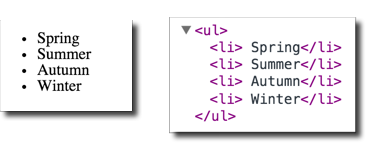
If needed, you can also pass in the index position as well (remember that the first item in an array is index position = 0, second item is index position = 1, etc.).
<ul>
{{#each seasons as |season pos|}}
<li>{{pos}} {{season}}</li>
{{/each}}
</ul>Which would produce: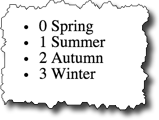
Handlebars Conditionals
Sometimes we might want to format data based on certain conditions. For example, if an email address or URL exists for a person, we might want to include a mailto: link or a link to the URL. Handlebar conditionals allow to do that.
People in JSON:
{
"people": [
{
"name": "Lawrence Bacow",
"url": "http://president.harvard.edu/"
},
{
"name": "Alan Garber",
"url": "http://provost.harvard.edu/people/alan-m-garber"
},
{
"name": "Katie Lapp"
}
]
};For example, if we wanted to hyperlink a name if a URL exists, our Handlebars template could look something like:
<ul>
{{#each people as |person|}}
<li>
{{#if person.url }}
<a href="{{person.url}}">{{person.name}}</a>
{{else}}
{{person.name}}
{{/if}}
</li>
{{/each}}
</ul>And this would produce:
Handlebars - Compiled Templates
It is possible to precompile your Handlebars template (the result is a JavaScript function), and then include the compiled templates via a script element.
Advantages of precompiling the templates include:
- Faster execution
- Can use lighter-weight Handlebars JS library (the "runtime" version, which doesn't have the compiler)
So here's an example where I've compiled the course list template into courseslist.js. Now there's no compile step, just a reference to Handlebars.templates.courseslist to access the template function. Note too that we are using the "runtime" version of the Handlebars library - handlebars.runtime.min.js
Note the command to compile the template looked like:
$ handlebars.js courseslist -f courseslist.jswhere courseslist is the source template, and courseslist.js is the generated compiled JS file
Maps
With JavaScript APIs for Google Maps, Bing Maps, and MapQuest, and Open Street Maps (Overpass API), it is very easy to embed customized maps on your website.
We'll take a look at a few different examples of how to include maps on our site:
- Embed a map created using vendor-provided tools
- Use the JavaScript API
- Custom Data
- Use standards such as GeoRSS
Each approach has some advantages and shortcomings. Essentially the trade-offs will be increased complexity with increased flexibility and control.
Embed a map created using Google's Tools
You can create a map using Google's tools, and then simply click the cog icon and select "Share or embed". The "embed map" option will give you an iframe code you can use in your web page. It doesn't get much simpler than this. If you want to embed a map with the location of a single store or organization, then this technique will work well.
A map I created for the John Harvard Statue:
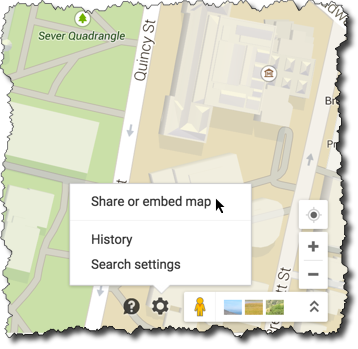
The iframe code provided by Google:
<iframe style="border: 0;"
src="https://www.google.com/maps/embed?pb=!1m14!1m8!1m3!1d1473.7541883076933!2d-71.11691195715973!3d42.37431548010373!3m2!1i1024!2i768!4f13.1!3m3!1m2!1s0x0%3A0x1b5299f9d1edac24!2sJohn+Harvard+Statue!5e0!3m2!1sen!2sus!4v1428381157098"
width="600" height="450"></iframe>And the map that is embedded:
For further information about the Google Map Embed API, please see
https://developers.google.com/maps/documentation/embed/guide
Cases where the embed approach wouldn't work so well:
- We need to create a map using information that changes
- We need to create a map using dynamically generated data
An example where a static embedded map would not work is with the Student Locations tool for this course. This tool allows students to enter their location information, and then the map is built dynamically based on this data. In addition, this tool displays different data, depending on whether the viewer is a student or an instructor. This is a case where we'll need more control over the map than a straightforward embed approach will allow.
The Google Maps JavaScript API will give us that control.
Google Maps JavaScript API
There is extensive documentation for the Google Maps JavaScript API, at
https://developers.google.com/maps/documentation/javascript/tutorial that you can consult. But for now, it will be enough to walk through some examples.
We'll learn by example with a
- basic map
- map with a marker
- map with a marker with an information window
- map with several markers
Basic Map
So first, we'll start with a map that is centered on the John Harvard statue in Harvard Yard.
To use the Google Maps JavaScript API, we'll need to load the Google Map JavaScript via a script element, and then we'll need to configure the map and then place it on the page.
Load the JavaScript:
<script src="https://maps.googleapis.com/maps/api/js?v=3.exp"> </script>Use the JavaScript:
var map;
/* John Harvard Statue
42.374474,-71.117207 */
var mylat = 42.374474;
var mylng = -71.117207;
function initialize_map() {
var mapOptions = {
zoom: 17,
center: new google.maps.LatLng(mylat, mylng)
};
map = new google.maps.Map(document.getElementById('map-canvas'),
mapOptions);
}
google.maps.event.addDomListener(window, 'load', initialize_map);- Latitude and Longitude of the John Harvard statue is (42.374474,-71.117207)
google.maps.event.addDomListeneris the Google Maps way of adding an event handler.
In this case, the event is the "load" event of the "window", and the handler is the functioninitialize_map- In the
initialize_mapfunction:mapOptionsis a JS data structure.zoomlevel is how close (larger is closer)google.maps.LatLngis the method that creates a Google Maps LatLng object. In this case, we are setting the center of the map to the location of the John Harvard statuegoogle.maps.Mapis the method to create a Google Map. We pass in as parameters where to place it on the page (note the DOM method,document.getElementById), and the second parameter is the data structure of map options
Full example:
Basic Map working examples:
Placing a Marker
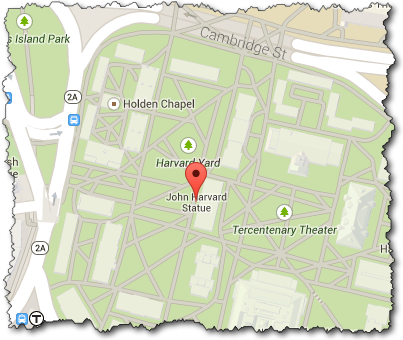
To put a marker on the map, we'll create a google.maps.Marker object. When we create the marker, one of the parameters we'll pass in as part of the configuration data structure is the map we want to place it on.
So if we've created a google.maps.Map object as the variable harvard_yard_map and a googlemaps.LatLng object as the variable latlng_statue, the new JavaScript code to create a marker for the John Harvard statue would look like:
var marker = new google.maps.Marker(
{
position: latlng_statue,
map: harvard_yard_map,
title: 'John Harvard Statue'
}
);Note there is a single parameter passed to the google.maps.Marker method -- this parameter is a JavaScript data structure of name/value pairs.
Full example:
Map with Marker working examples:
Read more about Markers, Google JavaScript API documentation for additional information, such as using customized icons.
Marker with an Information Window
Now that we have a marker on the map, we can add an information window.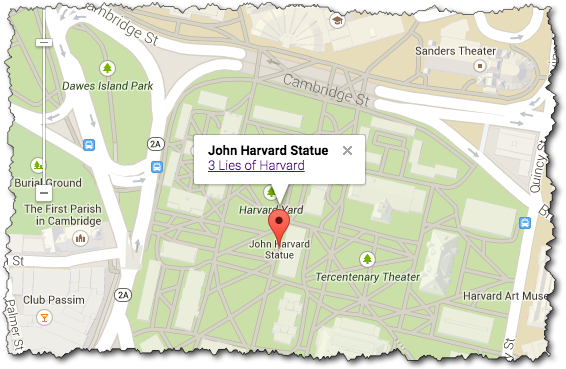
There are three basic things to pay attention to:
- Create content for the information window
- Create the
google.maps.InfoWindow - Add a listener so that a click event on the marker causes the information window to open
These steps are shown below:
/* Create content. Here we are concatenating strings together with the JS "+" operator */
var statue_info = "<strong>John Harvard Statue</strong><br/>" +
"<a href='http://www.summer.harvard.edu/blog-news-events/3-lies-harvard'>3 Lies of Harvard</a>";
/* Create the InfoWindow object; note we pass in the content */
var statue_infowindow = new google.maps.InfoWindow({
content: statue_info
});
/* Create the marker (we've seen this before) */
var statue_marker = new google.maps.Marker({
position: statue_latlng,
map: harvard_yard_map,
title: 'John Harvard Statue'
});
/* Create the listener so that the info window opens when the marker is clicked */
google.maps.event.addListener(statue_marker, 'click', function() {
statue_infowindow.open(harvard_yard_map,statue_marker);
});Full example:
Map with Marker working examples:
Map with Several Markers
Now let's use JSON data to add several markers to a page.
Map with Ivy Schools from JSON Data - Live Example
The JSON data (schools.json) we'll use is a list of schools in the Ivy League -- which contains a latitude, longitude, name, and URL.
We'll use jQuery to get the JSON data, and we'll use the Google Maps API to create the map. The full code is shown below, but the key part to creating the markers is where iterate through the list of schools:
for (var i in school_list) {
var school = school_list[i];
var mylatlng = new google.maps.LatLng(school.lat, school.lng);
var marker = new google.maps.Marker({
position: mylatlng,
map: ivy_map,
title: "school.name"
});
}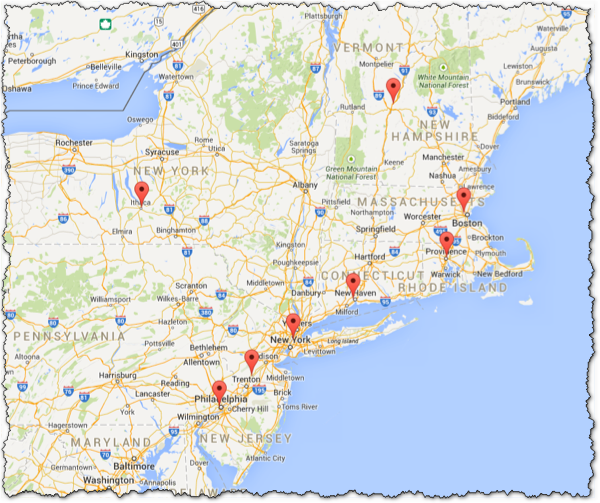
Full code:
Maps - Leaflet JS and Open Street Map
Leaflet: an open-source JavaScript library for mobile-friendly interactive maps
Pancake Menu
Mobile Pancake/Hamburger Menus
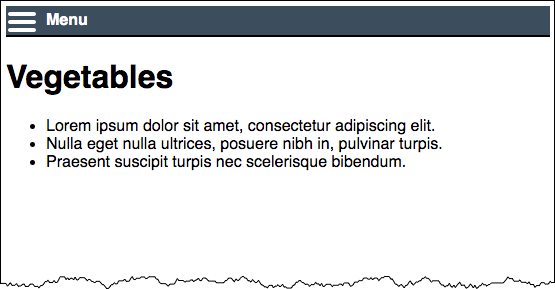
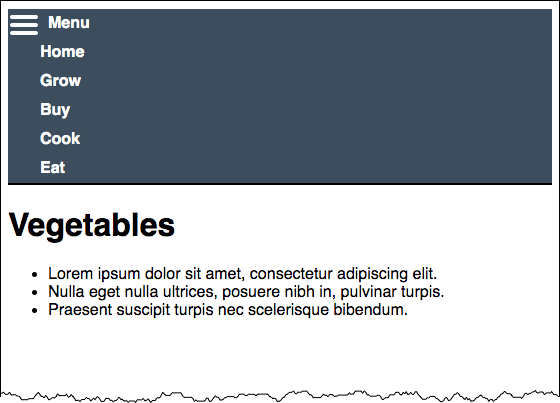
Form Price Calculation
Let's revisit the Dado Lunch Form, this time calculating a price!
